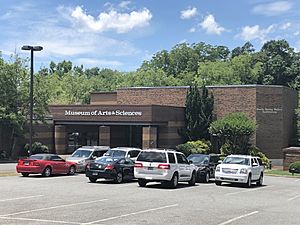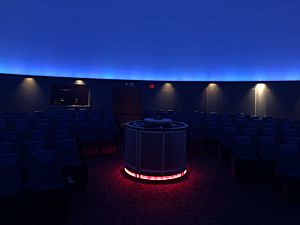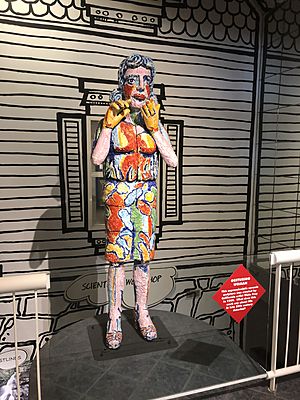Museum of Arts and Sciences (Macon, Georgia) facts for kids
The Museum of Arts and Sciences in Macon is a cool community museum in the U.S. state of Georgia. It's a place where you can explore both art and science! The museum has four main galleries with new exhibits often. You can also visit the Discovery House for hands-on fun, see live animals, and explore the Mark Smith Planetarium. There's even a nature trail and a garden to enjoy. The museum is open every day and offers special programs for schools and groups. It's a member of the American Alliance of Museums, which means it meets high standards for museums.
 |
|

Main Entrance in June 2019
|
|
| Established | 1956 |
|---|---|
| Location | 4182 Forsyth Road |
| Type | Art, Science |
| Accreditation | American Alliance of Museums |
Contents
Museum History
The Museum of Arts and Sciences first opened its doors in 1956. It started small, just one room at the Wesleyan Conservatory. This room had a few activities for kids to enjoy.
Growing Bigger
In 1964, the museum moved to a new spot. A special building was built with a gallery and a workshop. Just one year later, in 1965, a planetarium was added. This became a new part of the museum.
Major Additions
A big expansion happened in 1980. This added most of the main parts of the museum you see today. In 2001, even more new areas were built. These included the Discovery House, a new entrance lobby, and more classrooms.
Recent Updates
In 2018, another building was added. This new space gives visitors a great view of the peach orchard behind the museum. By the end of 2019, exciting new features were completed. These included a cool bat cave and an outdoor amphitheater for shows and events.
What to Explore
The Museum of Arts and Sciences has many exciting areas to discover. You can find art, science, and even live animals!
Art Gallery
The museum's art gallery shows a mix of art. Some pieces are always there, while others are temporary. These temporary exhibits change every four to six months. The gallery is usually split into three parts. One part holds the art that's always on display. The other two parts feature the changing exhibits. Past exhibits have shown amazing works like ceramics by Pablo Picasso. Others have featured American Impressionist paintings or beautiful art by Tiffany.
Mark Smith Planetarium
The Mark Smith Planetarium is a special dome where you can learn about space. It was built in 1965 and is near the museum's main entrance. The planetarium has two shows every day. These shows cover different topics about astronomy and space. The topics change every two months, so there's always something new to see. Inside the planetarium, a special projector can show over 4,000 stars! It creates a virtual sky for you to explore. The dome is about 40 feet wide and can seat up to 118 people.
Mini-Zoo
The Mini-Zoo is a fun part of the museum where you can see live animals. It's located next to the Discovery House. Over the years, it has been home to many different animals. These include monkeys, birds, snakes, and even an alligator! The Mini-Zoo is designed to look like a jungle. It has two levels, so you can view the animals from different spots. Sometimes, the animals even join in on shows in the museum's auditorium. These shows are led by the museum's animal caregivers.
Discovery House
The Discovery House is the biggest exhibit in the museum. It has three floors, each with a different focus. Before you go inside, you'll see a large sculpture called Gesturing Woman by Viola Frey.
- Upper Floor: This floor is all about visual art. You can do fun activities like making paper dolls. There's also a light box where you can create your own designs.
- Middle Floor: This level focuses on the humanities. It has activities that help you learn about the world. You can try writing poetry or explore a map room.
- Bottom Floor: This floor is dedicated to science. You can dig for fossils, just like a real paleontologist! There are also simple experiments about weather and magnetism. This section is home to "Ziggy," a 40-million-year-old whale fossil. You can also see a large taxidermy adult polar bear.
Outdoor Spaces
The museum grounds also have great outdoor areas to explore. You can find an amphitheater for performances and a pavilion. There's also a raptor retreat, a bat cave, and walking trails to enjoy nature.



